Effect of Nano-La2O3 and Mo on Wear Resistance of Ni60a/SiC Coatings by Laser Cladding
Abstract
1. Introduction
2. Materials and Methods
2.1. Materials
2.2. Laser-Cladding Parameters
2.3. Wear Test
2.4. Microscopic Morphology Characterization
3. Results and Discussion
3.1. Micro-Hardness and Phase Analysis of the Coatings
3.2. Wear Test Analysis
3.3. Microscopic Wear Morphology Analysis
3.4. Elemental Analysis of Coating
4. Conclusions
Author Contributions
Funding
Data Availability Statement
Conflicts of Interest
References
- Ning, C.T. Research on failure form, design criteria, design procedure and standardization of mechanical parts, Guide. Sci.-Technol. Mag. 2013, 32, 124. [Google Scholar]
- Wang, T.; Wen, B.Q.; Kan, Z.; Lin, J.B. Wear behavior of different materials applied on horizontal mixer blades used in the processing of total mixed rations. Trans. ASABE 2019, 62, 1743–1753. [Google Scholar] [CrossRef]
- Wang, T.; Kan, Z.; Li, J.B.; He, Q.; Wen, B.Q.; Li, J.J. Study on rural eco-tourism regionalization based on fuzzy evaluation-three dimensional magic cube. J. Chin. Agric. Mech. 2019, 4, 89–93+228. [Google Scholar]
- He, Q.; Li, A.L.; Qu, W.H.; Zhang, Y.; Kong, L. Investigation on friction and wear properties of high-temperature bearing steel 9Cr18Mo. Mater. Res.-Lbero-Am. J. 2018, 21, e20170715. [Google Scholar] [CrossRef]
- Lou, B.Y.; Chen, Z.; Bai, W.J.; Dong, G. Structure and erosion resistance of Ni60A/SiC coatting by laser cladding. Trans. Nonferr. Met. Soc. 2006, 16, 643–646. [Google Scholar] [CrossRef]
- Shahri, P.K.; HomChaudhuri, B.; Pulugurtha, S.S.; Mesbah, A.; Ghasemi, A.H. Traffic Congestion Control Using Distributed Extremum Seeking and Filtered Feedback Linearization Control Approaches. IEEE Contr. Syst. Lett. 2022, 7, 1003–1008. [Google Scholar] [CrossRef]
- Khorasani, M.; Ghasemi, A.H.; Leary, M.; Sharabian, E.; Cordova, L.; Gibson, L.; Downing, D.; Bateman, S.; Brandt, S.; Rolfe, B. The effect of absorption ratio on meltpool features in laser-based powder bed fusion of IN718. Opt. Laser Technol. 2022, 153, 108263. [Google Scholar] [CrossRef]
- Khorasani, M.; Gibson, I.; Ghasemi, A.H.; Hadavi, E.; Rolfe, B. Laser subtractive and laser powder bed fusion of metals: Review of process and production features. Rapid Prototyp. J. 2023, 1355–2546, ahead of print. [Google Scholar] [CrossRef]
- Zhang, W.P.; Liu, S. Microstructure of Fe-Ti-B composite coating prepared by laser cladding. Chin. J. Nonferr. Met. 2005, 15, 558–564. [Google Scholar]
- Guo, J.K. Multiphase material-an attractive trend for material research. Res. Dev. World Sci. Technol. 2000, 22, 17–18. [Google Scholar]
- Straumal, B.B.; Klinger, L.; Kuzmin, A.; Gabriel, A.; Anna, K.; Alexander, B. High entropy alloys coatings deposited by laser cladding: A review of grain boundary wetting phenomena. Coatings 2022, 12, 334. [Google Scholar] [CrossRef]
- Feng, X.D.; Yuan, Q.L.; Cao, J.J.; Su, Z.J. Microstructure and properties comparison of laser cladding layer and spraying layer of Ni-Based self-fluxing alloy. Mater. Mach. Eng. 2010, 34, 73–79. [Google Scholar]
- Dong, S.Z.; Ma, Z.; Pan, R.; Li, Z.C. Application of rare earth oxides to ceramic coatings. Electr. Finish 2012, 31, 76–80. [Google Scholar]
- Wang, Q.B.; Dou, X.W.; Chao, M.J.; Yuan, B.; Liang, E.J. Effect of Mo-doping on the microstructure and wear properties of laser-clad nickel-based coatings. Appl. Laser 2005, 25, 97–100. [Google Scholar]
- Yuan, J.P.; Zhang, P.; Liang, Z.J.; Ma, L. Effect of Mo and CeO2 on microstructure and properties of laser cladding Nickel-base alloy coatings. Rare Met. Mater. Eng. 2008, 37, 147–151. [Google Scholar]
- Li, W.H.; Ai, T.T.; Dong, H.F.; Zhang, G.J. Tribological properties of Mo-Si-B alloys doped with La2O3 and tested at 293–1173 K. Materials 2009, 12, 2011. [Google Scholar] [CrossRef] [PubMed]
- Zhang, H.A.; Hu, X.P.; Yan, J.H.; Chen, P.; Tang, S.W. Dry sliding wear behaviors of La2O3–WSi2–MoSi2 composite against alloy steel. Wear 2006, 260, 903–908. [Google Scholar] [CrossRef]
- Li, W.H.; Fu, S.H.; Ai, T.T.; Zhou, P.D.; Chen, J.; Zhang, G.J. Effect of La2O3 on friction and wear characteristics of Mo-25Si-8.5B alloy. Heat Treat. Met. 2019, 44, 18–21. [Google Scholar]
- Liu, J.; Chen, Y.; Zhang, J. Oxidation behavior of Ni–Mo–Si alloy coatings fabricated on carbon steel by laser cladding. Surf. Coat. Technol. 2019, 375, 903–910. [Google Scholar] [CrossRef]
- Huebner, J.; Kata, D.; Kusinski, J.; Rutkowski, P.; Lis, J. Microstructure of laser cladded carbide reinforced inconel 625 alloy for turbine blade application. Ceram. Int. 2017, 43, 8677–8684. [Google Scholar] [CrossRef]
- Corrêa, E.O.; Alcântara, N.G.; Valeriano, L.C.; Barbedo, N.D.; Chaves, R.R. The effect of microstructure on abrasive wear of a Fe–Cr–C–Nb hardfacing alloy deposited by the open arc welding process. Surf. Coat. Technol. 2015, 276, 479–484. [Google Scholar] [CrossRef]
- Torgerson, T.; Mantri, S.; Banerjee, R.; Scharf, T. Room and elevated temperature sliding wear behavior and mechanisms of additively manufactured novel precipitation strengthened metallic composites. Wear 2019, 426, 942–951. [Google Scholar] [CrossRef]
- Fayazfar, H.; Salarian, M.; Rogalsky, A.; Sarker, D.; Russo, P.; Paserin, V.; Toyserkani, E. A critical review of powder-based additive manufacturing of ferrous alloys: Process parameters, microstructure and mechanical properties. Mater. Des. 2018, 144, 98–128. [Google Scholar] [CrossRef]
- Alidokht, S.A.; Manimunda, P.; Yue, S.; Chromik, R. Cold spray deposition of a Ni-WC composite coating and its dry sliding wear behavior. Surf. Coat. Technol. 2016, 308, 424–434. [Google Scholar] [CrossRef]
- Róg, G.; Kozlowska-Rog, A.; Dudek, M. The standard Gibbs free energy of formation of calcium chromium (III) oxide in the temperature range (1073 to 1273) K. J. Chem. Therm. 2007, 39, 275–278. [Google Scholar] [CrossRef]
- Sun, S.T.; Fu, H.G.; Ping, X.L.; Guo, X.Y.; Jian, L.; Lei, Y.P.; Wu, W.B.; Zhou, J.X. Effect of liquid nitrogen cooling on grain growth and properties of laser cladding in-situ (Ti, Nb)C/Ni composite coatings. Mater. Charact. 2019, 152, 115–129. [Google Scholar] [CrossRef]
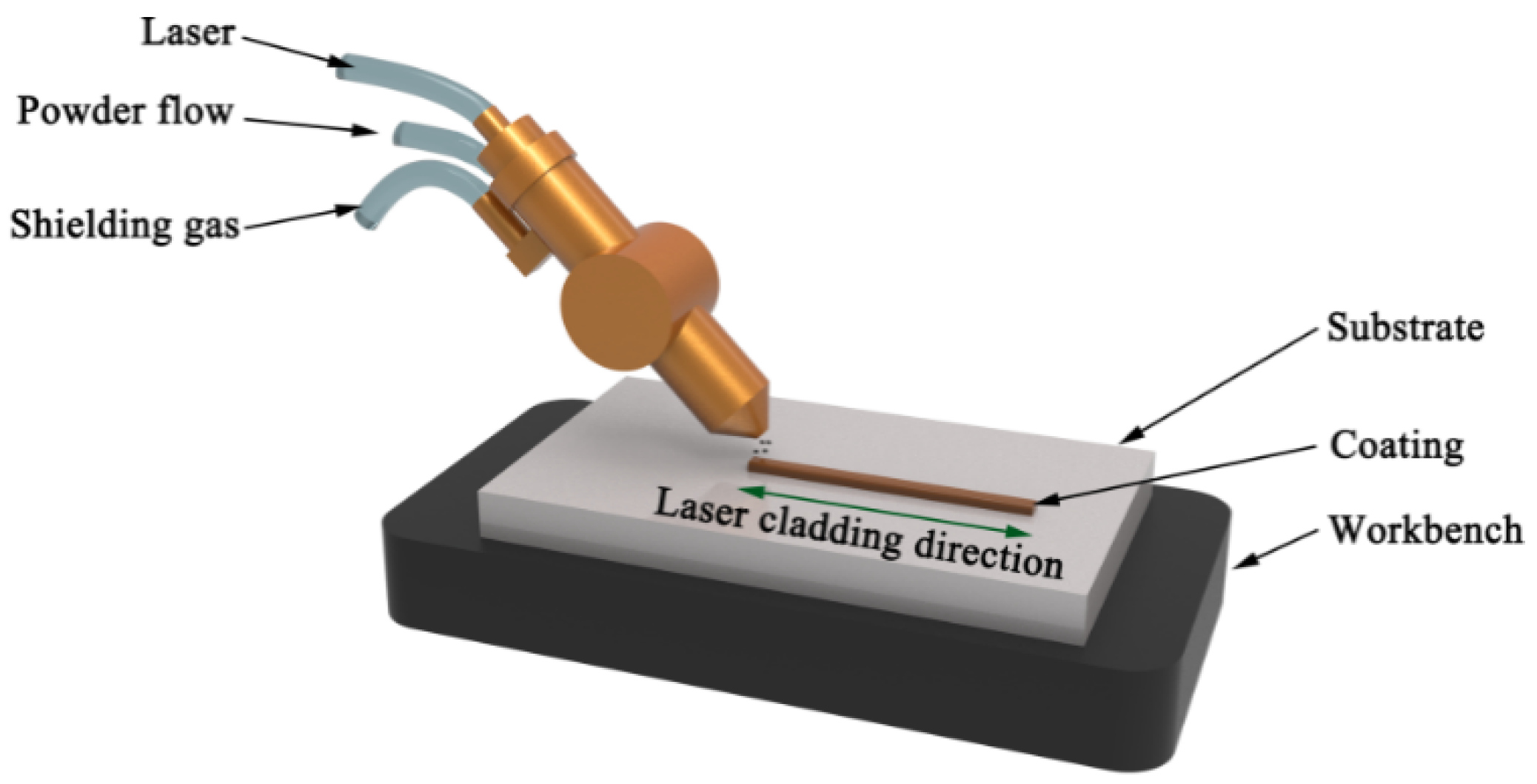
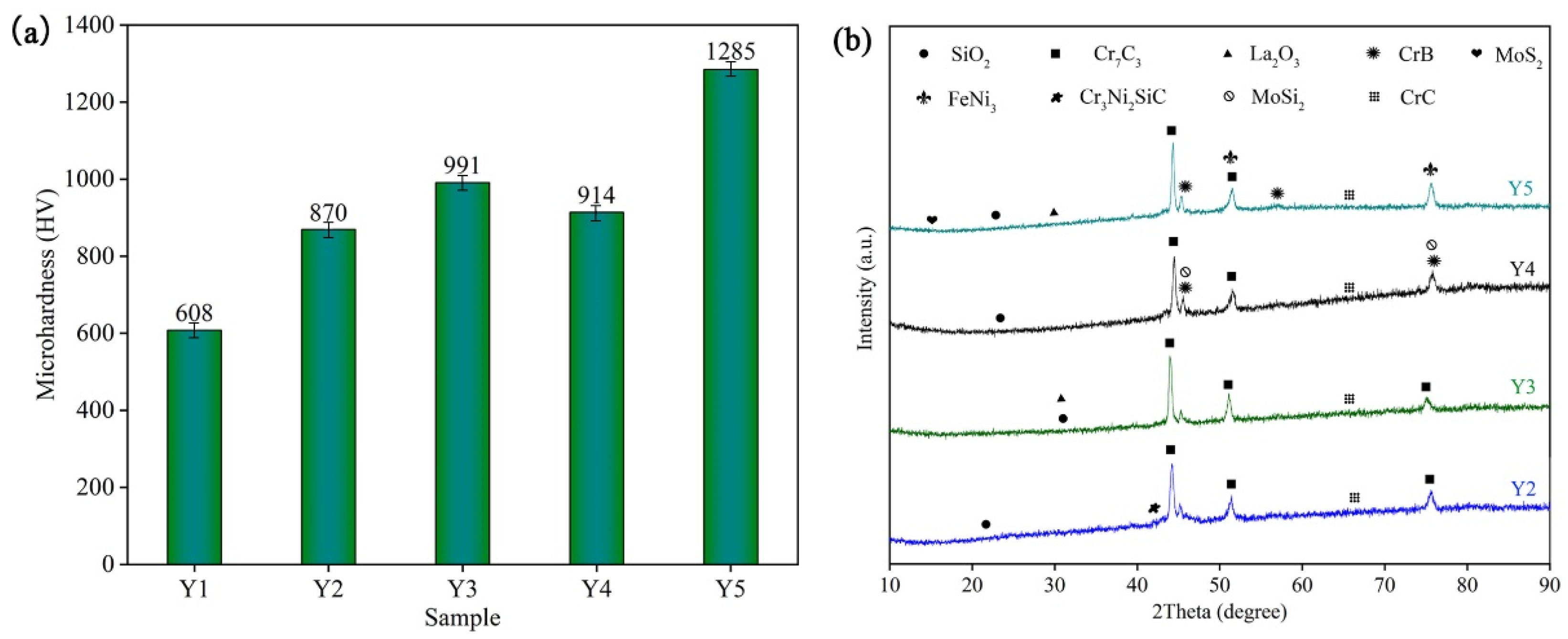
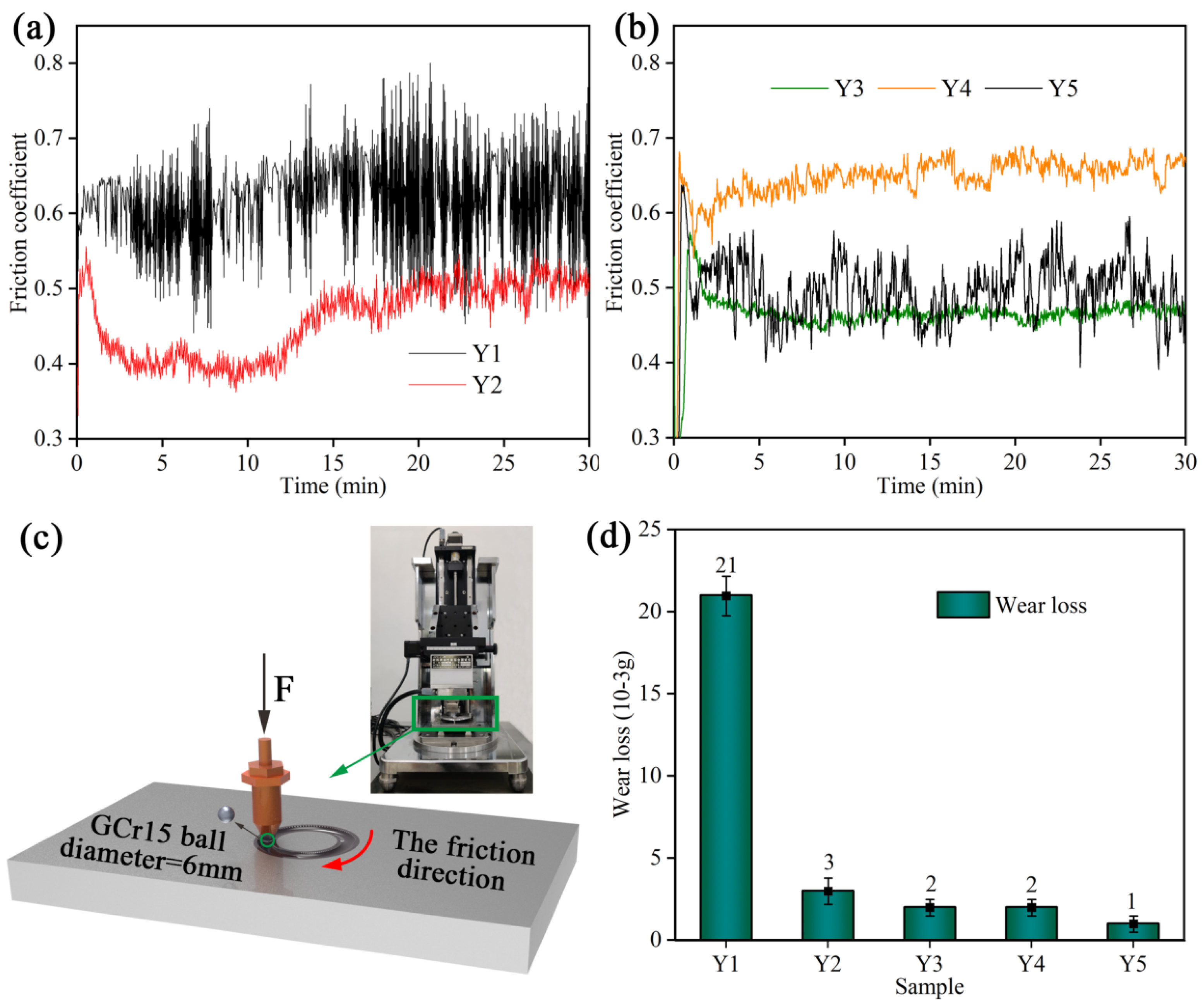

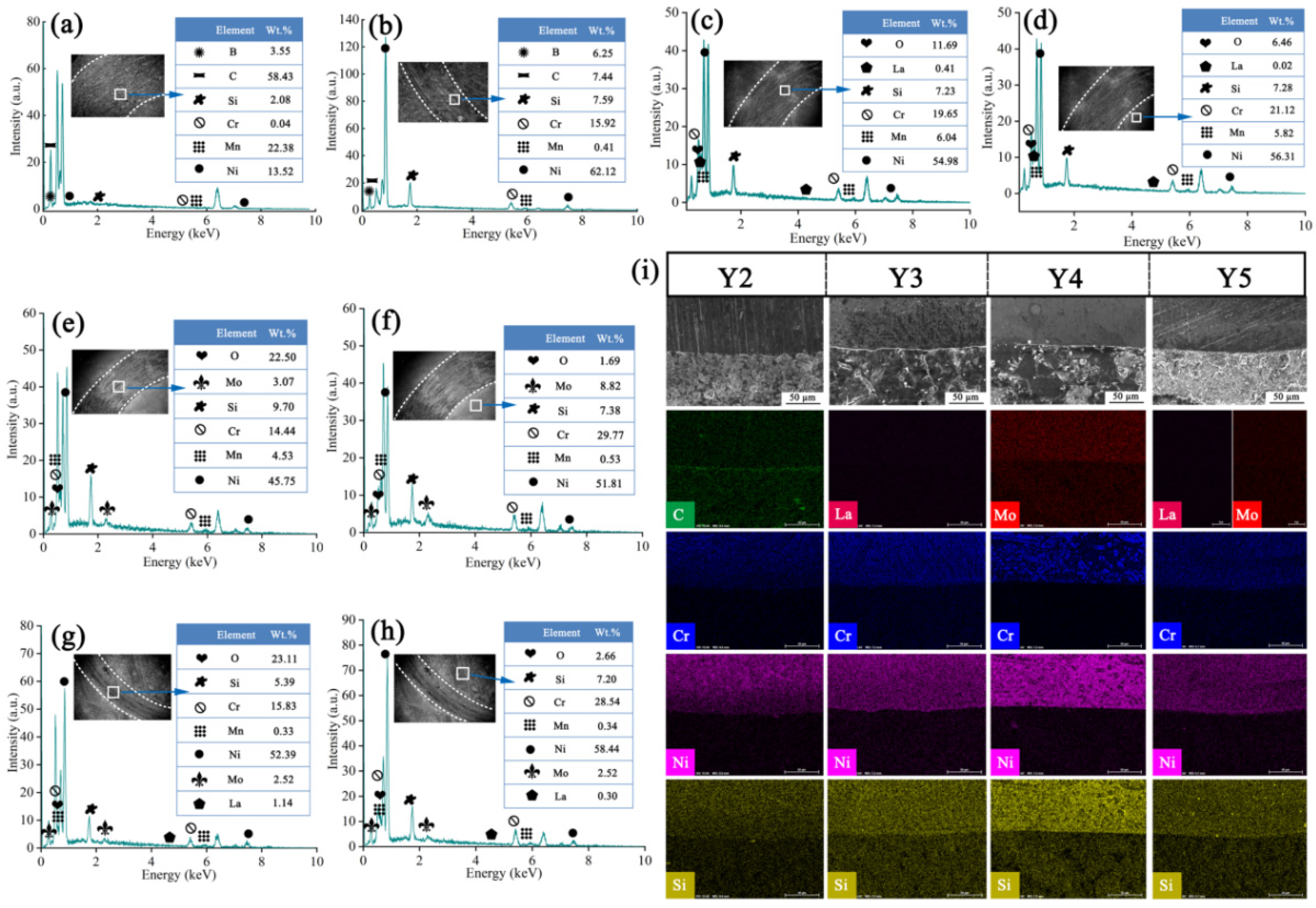
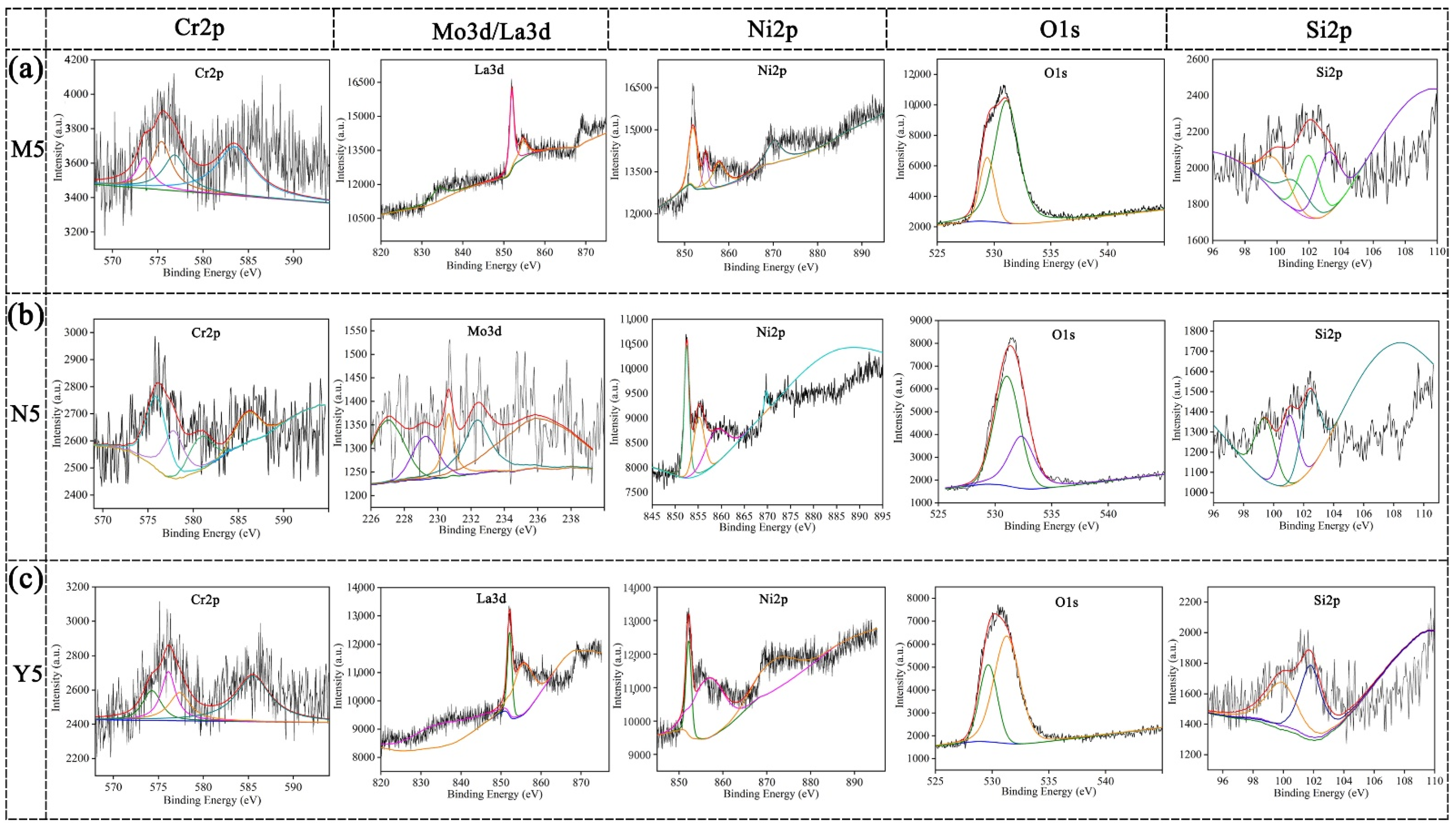
| Material | Element Composition (wt.%) | ||||||||
|---|---|---|---|---|---|---|---|---|---|
| C | Mn | Cr | Si | Ni | Cu | P | S | Fe | |
| 65Mn | 0.189 | 1.034 | 0.224 | 0.272 | 0.014 | 0.1782 | 0.011 | 0.0112 | Bal |
| Sample | Name |
|---|---|
| 65Mn | Y1 |
| 80 wt.% Ni60a + 20 wt.% SiC | Y2 |
| 78 wt.% Ni60a + 20 wt.% SiC + 2 wt.% La2O3 | Y3 |
| 76.5 wt.% Ni60a + 20 wt.% SiC + 3.5 wt.% Mo | Y4 |
| 74.5 wt.% Ni60a + 20 wt.% SiC + 2 wt.% La2O3 + 3.5 wt.% Mo | Y5 |
| Process Parameters | Operation Range |
|---|---|
| Laser power (W) | 2000 |
| Scanning speed (mm/min) | 400 |
| Spot diameter (mm) | 3 |
| Overlap rate (%) | 45 |
| Defocus distance (mm) | 10 |
| Powder feeding rate (g/min) | 8 |
| Protecting gas (Ar, L/min) | 8 |
Disclaimer/Publisher’s Note: The statements, opinions and data contained in all publications are solely those of the individual author(s) and contributor(s) and not of MDPI and/or the editor(s). MDPI and/or the editor(s) disclaim responsibility for any injury to people or property resulting from any ideas, methods, instructions or products referred to in the content. |
© 2023 by the authors. Licensee MDPI, Basel, Switzerland. This article is an open access article distributed under the terms and conditions of the Creative Commons Attribution (CC BY) license (https://creativecommons.org/licenses/by/4.0/).
Share and Cite
Fang, Y.; Chen, X. Effect of Nano-La2O3 and Mo on Wear Resistance of Ni60a/SiC Coatings by Laser Cladding. Processes 2023, 11, 850. https://doi.org/10.3390/pr11030850
Fang Y, Chen X. Effect of Nano-La2O3 and Mo on Wear Resistance of Ni60a/SiC Coatings by Laser Cladding. Processes. 2023; 11(3):850. https://doi.org/10.3390/pr11030850
Chicago/Turabian StyleFang, Yudong, and Xuemei Chen. 2023. "Effect of Nano-La2O3 and Mo on Wear Resistance of Ni60a/SiC Coatings by Laser Cladding" Processes 11, no. 3: 850. https://doi.org/10.3390/pr11030850
APA StyleFang, Y., & Chen, X. (2023). Effect of Nano-La2O3 and Mo on Wear Resistance of Ni60a/SiC Coatings by Laser Cladding. Processes, 11(3), 850. https://doi.org/10.3390/pr11030850






